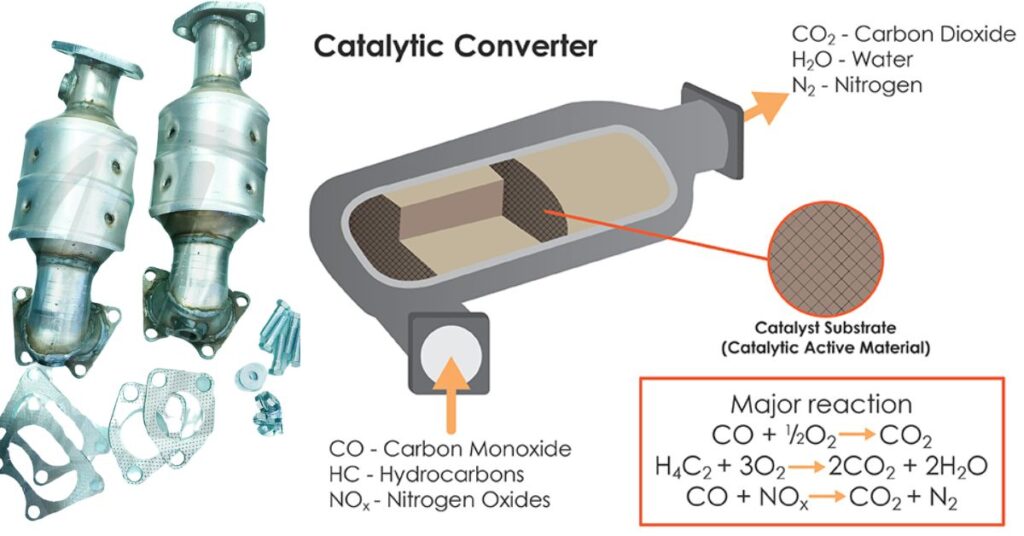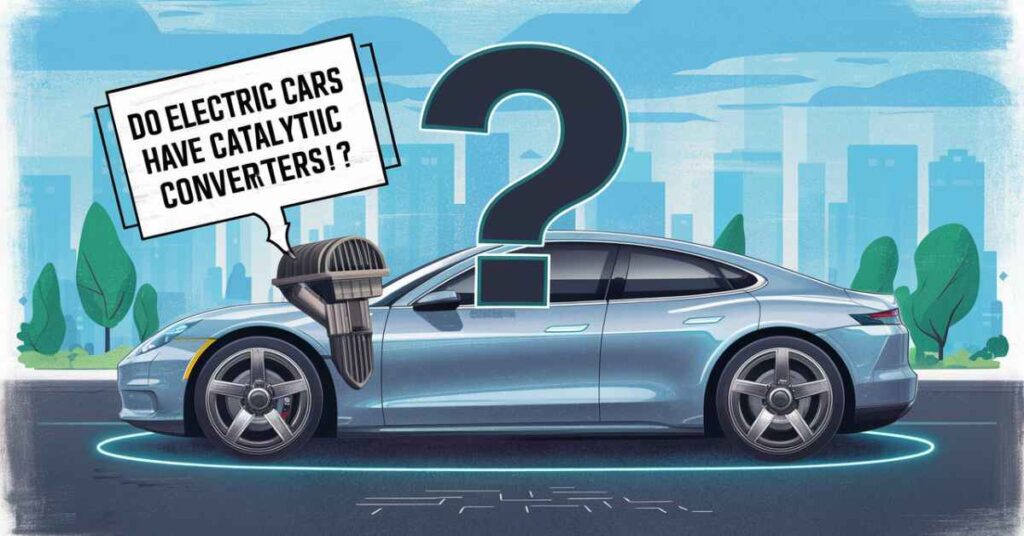As electric vehicles (EVs) continue to gain traction and capture the interest of eco-conscious drivers worldwide, questions about their internal components and mechanics naturally arise.
One such query revolves around the presence (or absence) of catalytic converters in these emission-free automobiles. So, do electric cars have catalytic converters?
Before we delve into the specifics, let’s first understand what a catalytic converter is and its role in traditional gasoline-powered vehicles.
A catalytic converter is an exhaust emission control device that converts harmful pollutants like carbon monoxide (CO), hydrocarbons (HC), and nitrogen oxides (NOx) into less toxic substances like carbon dioxide (CO2), water (H2O), and nitrogen (N2).
These components are crucial in meeting emission regulations and reducing the environmental impact of internal combustion engines.
Understanding Catalytic Converters and Their Role in Gasoline Cars

In gasoline cars, the catalytic converter is an integral part of the exhaust system, positioned downstream from the engine’s cylinders. As the engine burns fuel, it produces various byproducts, including the aforementioned pollutants.
The catalytic converter uses precious metals like platinum, palladium, and rhodium as catalysts to facilitate chemical reactions that break down these harmful substances.
The catalyst’s honeycomb-like structure provides a large surface area for the reactions to occur efficiently.
As the exhaust gases flow through the catalytic converter, the catalysts promote the oxidation of carbon monoxide and hydrocarbons, as well as the reduction of nitrogen oxides, resulting in cleaner emissions.
However, electric cars operate on a fundamentally different principle than gasoline-powered vehicles.
Instead of an internal combustion engine, EVs employ an electric motor powered by rechargeable batteries. This means there is no combustion process and, consequently, no exhaust emissions to treat.
Read the Blog:
Do Electric Cars Really Need Catalytic Converters?
In most cases, the answer is a resounding no. Since electric cars do not have internal combustion engines and do not produce exhaust emissions, they generally do not require catalytic converters.
Benefits of Not Having a Catalytic Converter in EVs
The absence of a catalytic converter in electric vehicles brings about several benefits:
- Cost Savings:
Catalytic converters are expensive components, often containing precious metals. By eliminating the need for this part, EV manufacturers and owners can enjoy significant cost savings over the vehicle’s lifetime.
- Reduced Maintenance:
Catalytic converters can degrade over time due to factors like high temperatures, contaminants, and physical damage. Without this component, electric car owners can avoid the hassle and expense of regular checks and potential replacements.
Exceptions: Electric Cars with Catalytic Converters

While the vast majority of electric cars do not have catalytic converters, there are a few exceptions where these components may be present:
- Plug-in Hybrid Electric Vehicles (PHEVs):
PHEVs combine an electric motor with a gasoline-powered internal combustion engine, often referred to as a “range extender.” In these cases, a catalytic converter may be included to treat the exhaust emissions from the gasoline engine when it is in use.
- Certain EVs with Combustion Heaters:
Some electric vehicles, particularly those designed for colder climates, may incorporate a small combustion heater to provide cabin warmth. These heaters burn fuel and produce emissions, necessitating the use of a catalytic converter for compliance with emission regulations.
- Regional Emission Regulations:
Certain regions or countries may have specific emission regulations that require the installation of catalytic converters in electric vehicles, even if they do not have internal combustion engines.
It’s important to note that these exceptions are relatively rare, and most dedicated electric vehicles on the market today do not have catalytic converters.
Catalytic Converter Theft and Electric Cars
In recent years, catalytic converter theft has become a growing concern for gasoline car owners due to the precious metals contained within these components.
Thieves target catalytic converters for their valuable materials, causing significant inconvenience and repair costs for victims.
Electric car owners, however, can breathe a sigh of relief as they are largely immune to this type of crime. Since the vast majority of EVs do not have catalytic converters, the risk of falling victim to this theft is significantly reduced.
Read More:
Environmental Impact of Electric Cars without Catalytic Converters

One of the primary advantages of electric vehicles is their reduced environmental impact compared to gasoline-powered counterparts. By eliminating the need for catalytic converters, EVs take this eco-friendly aspect a step further.
Electric cars produce zero direct tailpipe emissions, contributing to cleaner air in urban areas and reducing the overall carbon footprint of transportation.
While the production of electricity used to charge EV batteries may have an environmental impact, this impact can be minimized by sourcing electricity from renewable sources like solar, wind, or hydroelectric power.
As the world continues to prioritize sustainability and combat climate change, the adoption of electric vehicles without catalytic converters aligns with the goals of reducing greenhouse gas emissions and promoting a greener future for transportation.
Looking ahead, it is likely that emission regulations will become even more stringent, further driving the transition towards zero-emission vehicles like electric cars.
As technology advances and battery capacities increase, the range and practicality of EVs will continue to improve, making them an increasingly attractive choice for environmentally conscious consumers.
Conclusion
In conclusion, the vast majority of electric cars do not have catalytic converters. This absence is due to the fundamental differences between electric motors and internal combustion engines, with the former producing no exhaust emissions that require treatment.
By eliminating the need for catalytic converters, electric vehicles offer several advantages, including cost savings, reduced maintenance requirements, and a lower risk of catalytic converter theft.
The lack of direct emissions from EVs contributes to a cleaner environment and aligns with the global push towards sustainable transportation solutions.
Frequently Asked Questions
How much does it cost to tint a car all around?
Tinting a car all around typically costs between $100 and $400, depending on the vehicle and quality of tint, with premium options reaching up to $800.
How much is window tint in NC?
In North Carolina, window tinting costs range from $100 to $500, varying by car size and tint type, with higher-end tints costing more.
Is 5 tint legal in Florida?
No, 5% tint (very dark) is not legal on most windows in Florida, except for the rear window if you have side mirrors, ensuring driver visibility.
What is legal tint in Texas?
In Texas, the legal tint is 25% VLT on front side windows and any darkness on rear side windows and back window, promoting safety and visibility.
Is 20% tint illegal in NC?
Yes, 20% tint is illegal on the front side windows in North Carolina, where the legal limit is 35% VLT, to ensure sufficient light transmission.
Can I get away with 30% tint in NC?
Yes, 30% tint is legal on all windows in North Carolina, as the limit is 35% VLT for front side windows, balancing privacy and visibility.







